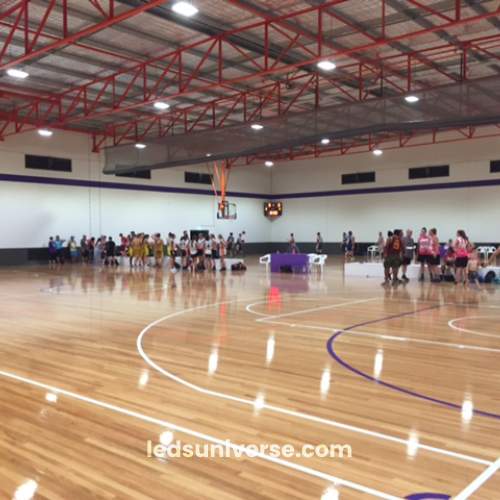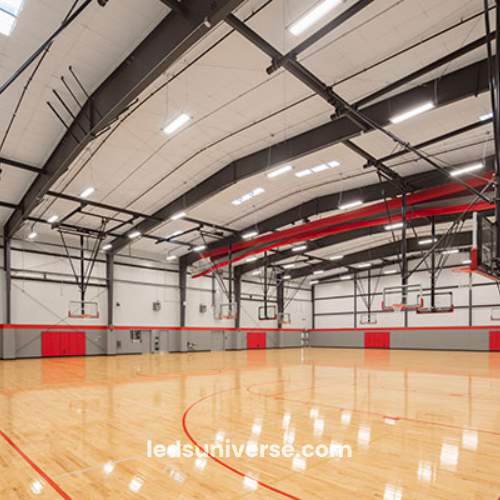In the bustling world of fitness and wellness, the right lighting can transform a gym from a mundane space into an energizing haven for exercise and recovery. This is the promise of modern LED lighting, which has revolutionized gym environments by combining cutting-edge technology with unparalleled functionality.
Effective lighting impacts everything from the atmosphere to the functionality of the space. Well-designed gym lighting enhances visibility, supports various activities, and creates an inviting environment for all users. We will delve into key aspects of gym lighting, including design considerations, maintenance, and durability, and highlights why LED lighting is the superior choice for modern gyms.
Reach out for free lighting consultation
Table of Contents
Toggle
Different areas of a gym have varying lighting needs. For instance, weightlifting areas require higher lux levels to ensure that exercises can be performed safely and with precision. Cardio areas, on the other hand, might benefit from slightly lower but still adequate lighting. The recommended lux levels typically range from 300 to 700 lux depending on the area’s specific function. Proper brightness helps in reducing the risk of accidents and ensures that all activities, from stretching to intense training, can be conducted without visual strain.
The color temperature of gym lighting plays a significant role in setting the right mood and improving performance. Cooler color temperatures (4000K to 5000K) are generally preferred in gyms because they mimic natural daylight, which helps in keeping energy levels high and enhancing focus. Cooler lights also help in reducing eye strain and improving the visibility of detailed movements. Conversely, warmer color temperatures can create a more relaxed atmosphere, but they may not be suitable for high-intensity workout areas.
Uniform lighting distribution is essential in a gym to avoid harsh shadows and glaring spots. Uneven lighting can lead to discomfort and can hinder exercise performance. Achieving uniformity involves strategically placing light fixtures to cover the entire space evenly. This is especially important in large areas like gym floors and courts where even light distribution contributes to a safer and more enjoyable workout environment.

LED lighting has significantly transformed the way gyms are illuminated, offering a host of advantages over traditional lighting solutions. One of the most notable benefits is their superior energy efficiency. LEDs use up to 70% less energy than conventional incandescent or fluorescent lights. This remarkable efficiency not only results in substantial savings on energy bills but also contributes to a reduced environmental impact. The lower energy consumption of LEDs helps decrease the overall carbon footprint of gym operations, aligning with broader sustainability goals.
Another major advantage of LED lighting is its extended lifespan. LEDs can last up to 50,000 hours, a significant improvement over the typical 10,000 hours provided by traditional bulbs. This longevity translates to fewer replacements and lower maintenance costs. The reduced need for frequent bulb changes minimizes interruptions to gym activities and ensures consistent lighting performance. Investing in LEDs ultimately leads to long-term cost savings and a more reliable lighting solution.
LED lights offer superior brightness and versatility compared to other lighting options. They can be easily dimmed to suit various activities within a gym, which is essential for accommodating different lighting needs. For example, high-intensity workouts benefit from bright, focused lighting, while calming activities like yoga may require a softer, more subdued light. The ability to adjust light levels ensures that all areas of the gym are adequately lit, enhancing both functionality and comfort for users.
In addition to their energy efficiency and longevity, LEDs are also more environmentally friendly. Unlike traditional lighting options, LEDs do not contain hazardous substances such as mercury, which can pose health risks and require special disposal procedures. The absence of these harmful chemicals makes LEDs a safer choice for gyms and other facilities. Furthermore, LEDs convert up to 95% of energy into light, with minimal heat emission. This efficiency helps in reducing the risk of overheating and contributes to a safer and more eco-friendly lighting solution.
Effective maintenance is crucial for ensuring that gym lighting remains in optimal condition. Regular cleaning and inspections are necessary to maintain the performance and longevity of lighting fixtures. Dust and dirt can accumulate on light fixtures, which may reduce their brightness and potentially cause issues such as overheating. Routine cleaning helps to preserve the clarity and effectiveness of the lights, ensuring that they continue to operate at peak efficiency. Additionally, periodic checks for signs of damage or malfunction are essential to prevent unexpected outages that could disrupt gym activities.
Gym environments are often subject to demanding conditions, including high traffic, occasional impacts, and fluctuating temperatures. Therefore, selecting durable lighting fixtures is essential for maintaining reliable performance. LED lights are particularly well-suited for these challenging conditions due to their robust construction and resistance to shock and vibration. Unlike traditional lighting options, LEDs are less prone to breakage and can withstand the physical stresses of a busy gym setting. Their resistance to temperature variations ensures consistent performance across different seasons, making them a dependable choice for long-term use.
LED lighting stands out as the premier choice for gym lighting due to its impressive brightness and energy efficiency. LEDs can save up to 70% in energy costs compared to traditional lighting sources such as incandescent and fluorescent bulbs. This significant reduction in energy consumption not only lowers operating expenses but also contributes to a more sustainable environment. LEDs deliver bright, uniform light that enhances visibility throughout the gym, reducing shadows and creating a safer workout space.
One of the key advantages of LED lighting is its precise control over light levels. In a gym setting, where different activities demand varying lighting intensities, this flexibility is invaluable. For high-intensity sports like basketball, bright, focused lighting is necessary to ensure optimal performance and safety. Conversely, in areas designated for more tranquil activities, such as yoga or stretching, the ability to dim the lights can create a calming atmosphere conducive to relaxation and focus. Dimmable LED lights allow for easy adjustment of light levels, minimizing glare and enhancing overall comfort for gym-goers.
Safety is a paramount concern in any gym, and LED lighting excels in this aspect by providing superior illumination. The even distribution of light across the gym floor helps reduce the risk of accidents by ensuring that all areas are well-lit and free from hazardous shadows. This is especially important during high-intensity workouts or sports activities where clear visibility is crucial. LED lighting’s ability to deliver bright, consistent light helps improve overall visibility, making the gym a safer environment for all users.
In addition to their performance benefits, LEDs are also environmentally friendly. They convert up to 95% of the energy they consume into light, with minimal heat emission. This high efficiency not only reduces energy consumption but also decreases the carbon footprint associated with gym operations. Furthermore, LEDs do not contain hazardous substances like mercury, which are present in some traditional lighting options. This makes LED lighting a safer and more eco-friendly choice, reducing the need for special disposal procedures and contributing to a cleaner, greener environment.
LED lights are renowned for their long lifespan compared to traditional lighting options. While conventional bulbs may need to be replaced frequently, LEDs can last up to 50,000 hours or more. This durability translates to fewer replacements and lower maintenance costs over time. The reduced frequency of bulb changes also minimizes disruption to gym operations, ensuring that the lighting remains consistent and reliable. In the long run, the cost-effectiveness of LEDs makes them a smart investment for gyms, providing high-quality illumination and significant savings on energy and maintenance expenses.
By focusing on key design considerations like brightness, color temperature, and uniformity, gyms can create an optimal environment for users. LED lighting emerges as the superior choice due to its energy efficiency, durability, and adaptability. With advancements in lighting technology, including smart systems and customization options, gyms can look forward to even more innovative and efficient lighting solutions in the future. Investing in high-quality lighting not only improves the functionality of the gym but also contributes to a more enjoyable and motivating workout experience.